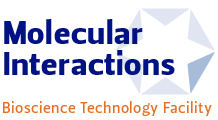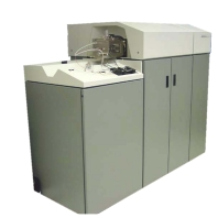Electrospray mass spectrometry
A protein in a suitable solvent is sprayed from a fine electrically charged nozzle, creating droplets from which the solvent evaporates leaving the protein molecules as charged particles. These are introduced into a mass analyser which measures their mass/charge ratio (m/z). As m/z can be measured to high accuracy (1 part in 10000 or better) the mass of the protein molecules can be determined. The resolution is much better than any other physical technique, allowing tiny changes such as mutation of a single amino acid residue or addition of a modifying group to be detected, where this might be difficult or impossible e.g. by gel electrophoresis or activity measurements.
Applications
Some applications:
- Checking that the mass of a protein expressed protein, are you sure that it has not suffered any unexpected modifications or degradation between DNA and protein?
- Checking site directed mutations: you will probably have checked your mutation by sequencing, but it is often advisable to check that the corresponding change has happened in the final protein product, especially when there is an unexpected change or lack of change in the functional behaviour.
- Modifications: if you have treated a protein with some chemical reagent, perhaps to modify activity or install a probe of some type, mass spectrometry is a useful way of checking the extent and selectivity of the process - has the protein all been modified once, or do you have a distribution with some unmodified material, some modified once and some modified twice or more?
- Isotopic incorporation: for some applications, notably NMR, and MAD phasing in crystallography, proteins labelled with isotopes such as 15N, 13C or amino-acid analogues like selenomethionine are required. These materials are almost indistinguishable from their unlabelled counterparts (that is part of the point in making them!) so how do you tell that you have usable material before wasting valuable machine time? If you know the amino acid sequence, and you measure the mass, then it is possible to calculate the percentage of incorporation, and often also to check that full length protein is actually being produced.
Facilities
ABI Qstar tandem mass spectrometer with IonSpray, Micro-IonSpray and NanoSpray sources.
Samples
Electrospray depends on getting the protein (or other macromolecule) from the solution in the droplet into the gas phase. This occurs at the surface of the drops and depends in part on repulsion between the charges on the molecules. Hence very ionic substances such as salts interfere, as do surface active molecules like detergents. The solvents used are normally a mixture of water with an organic component such as methanol or acetonitrile, often with a small amount of modifier (ammonia or formic acid) to provide the initial charges.
The ideal sample is 20 ul of a 100 uM pure protein solution in pure water. Buffers, salt and other solution constituents should be removed by dialysis or buffer exchange into water - but many proteins do not appreciate this and fall out of solution or stick to the membranes. We have found that samples in 2 - 5 mM Tris are often usable; salt, phosphates, citrates, detergents are troublesome and every effort should be made to remove them. "Good" buffers (HEPES, MOPS etc) are usually bad for mass spectrometry - they swamp out the protein signal with their own. DTT and EDTA in small quantities (1 mM or less) are not usually a problem. The more concentrated you can supply the protein the better, as this allows us to dilute in the analysis solvent and thereby minimise interference from buffer and other components. Some protein impurity is tolerable but complex mixtures are difficult. If you think these sample conditions are unachievable (quantity or quality), come and tell us what you can do and we will try to work out a suitable compromise. When all else fails we have dissolved washed crystals and precipitates directly in acetonitrile-water-formic acid and had usable results!


